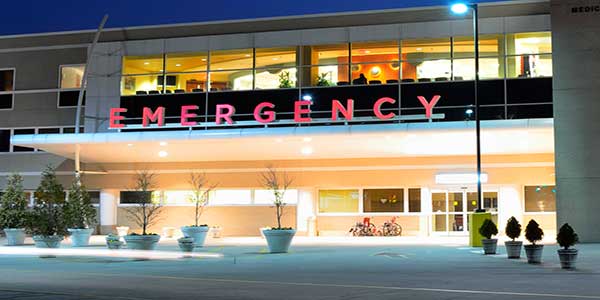Emergency Room
Emergency rooms are for emergency situations that could require rapid or advanced treatment that may only be available in a hospital setting.

Emergency Care
In an emergency, you should get care from the closest hospital that can help you. That hospital will treat you regardless of whether you have insurance.
♦ Emergency rooms are the best place for treating severe and life-threatening conditions. They’re open 24 hours, seven days a week.
They have the widest range of services for emergency after-hours care, including diagnostic tests and access to specialists.
That specialized care also makes it the most expensive type of care. And you'll probably have to wait a long time to get treated.
♦ Insurance plans cannot make you pay more in copayments or coinsurance if you get emergency care from an out-of-network hospital.
However, the reason for the visit must be a true emergency. Something that is severe or life-threatening, a broken leg or symptoms of a heart attack for example.
♦ In 2017, Blue Cross Blue Shield made waves when they announced they would not pay ER visits if they determined the visit was not a true emergency. There has been a lot of outcry over this policy since the average person is not likely to understand what a true emergency is.
♦ A hospital and any doctor outside your plan’s network are not required to accept what your plan decides is reasonable and customary to pay for the services you received during the emergency.
They can and probably will bill you for the difference. This is called ‘balance billing’. They are usually willing to negotiate this down.
♦ Unfortunately, in an emergency room situation you might be visited by more than one specialist. You might have imaging tests done that are actually read by someone in another part of the country or even in a foreign country.
This puts you at much greater risk of encountering a provider that is not in your network.
♦ More and more these days people are visiting an in-network hospital only to learn weeks later that they have large bills from doctors that are not in their network.
This is can be a financial disaster if you have a plan that does not have out-of-network benefits, like an HMO.
♦ The No Surprise Act was signed into law in 2020. It went into effect on January 2022.
It protects consumers with most types of private health insurance coverage from certain surprise medical bills.
The new federal legislation goes a long way toward reining in surprise billing from non-network providers who are likely to be practicing in your network hospital or urgent care.
The No Surprises Act supplements state surprise billing law protections; it does not replace them.
When to choose an emergency room
Symptoms best evaluated in an emergency room include:
• Weakness or numbness on one side
• Fainting
• Change in mental state
• Heavy bleeding
• Large wounds
• Chest pains
• Burns
• Head injuries
• Difficulty breathing
• Broken bones
• Serious allergic reactions
• Seizures
• Severe cold or flu symptoms
♦ If you are uncertain, call your plan's nurse hotline for advice (most plans provide this as a 24-hour free service).
► Trust your feeling. If your intuition tells you it's serious, don't hesitate. Go to the nearest emergency room.
Advantages of a hospital emergency room?
Hospital emergency rooms provide care at any time, day or night.
They have the staff and equipment to handle the most complicated and critical health issues, including life-threatening situations like heart attacks and strokes to traumatic injuries from a car accident.
Some types of treatments, such as surgery are only available in a hospital setting.
Do I need to call my insurance company first?
In a true emergency, go straight to the hospital.
Insurers can’t require you to get prior approval before getting emergency room services from a provider or hospital outside your plan’s network.
Will I have to pay anything?
This depends on the plan that you chose and the hospital you go to.
Most plans sold at the Marketplace have now shifted a lot of the emergency room costs to the patient. Read your plans Summary of Benefits and Coverage (SBC) carefully.
Most plans now specify that your annual deductible first be met before they will pay anything.
If you have met your deductible you will most likely have a coinsurance of 20% or more. Gone are the days when you could pay a $75 copay and go home and recover.
• You can be sure a hospital staff will visit your bed before you leave to give you the bad news.
Often someone will ask you to pay something before you leave. You can refuse to pay on the spot.
• Instead, ask them to send you a bill.
You then wait for your insurance company to sort out the bills.
♦ If you pay on the day you visit and later learn you over paid, it is almost always a very long and nerve racking process to get your money back.
Summary
Hospital emergency rooms provide medical care at any time, day or night. Unlike urgent care centers or walk-in clinics, they are equipped and staffed for even the most complex and critical needs.
Emergency rooms are the best place for treating severe and life-threatening conditions.

